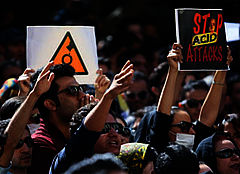The Case of Acid Throwings in Isfahan Remains on the Chief’s Desk
» No Prime Suspect Arrested
With seven months since Iranian media first reported a series of acid throwing incidents in Isfahan, a senior police official announced that the cases were still in the investigation phase. General Mohammad-Reza Moghimi, the head of the country’s police force said that he was personally working on the case and was “hopeful” about finding the prime suspect.
He also announced the arrest of an Isfahani burgler whose conditions “matched” those of the suspect in the acid throwing case while adding that he was not the prime suspect in the acid cases and that the investigation was still in progress. The thief, according to the chief, robbed houses and then put them on fire. Moghimi claimed that cases of burglary had come down in Isfahan since this man’s arrest. He did not provide an explanation as to why would a convicted criminal throw acid on women in their cars.
Last year, the then chief of police had implied in his interviews that some cases would perhaps never be closed or could take years to find their suspects. General Ismail Ahmadi Moghadam also took a jab at officials and said there was a “general perception” among some officials that “police had the power to solve every crime. It was as if we are hiding the acid throwers.”
Instead of the Acid Throwers, Journalists and Civil Activists Are Arrested
Last year when the media first published news about the acid throwing incidents in Isfahan, the public was appalled and reacted, just as international media gave wide coverage to the incidents. And while unofficial figures have put the number of victims of these acid attacks at eight officials have settled on four, and that too after contradictory numbers and remarks.
From the very first instance of acid throwings, the general public view was that the attacker were engaging in these acts as their way of combating women who were in their view not properly dressed. This argument invariably sucked in the state vice police which has the responsibility of warning such women and enforcing the Islamic attire code in the country. But this public view was strongly challenged by Majlis representatives, the judiciary, Friday imams, the armed forces and the police. The media was warned not to reports its stories based on this assumption.
But despite the mobilization of all the security, military and law enforcement agencies of the country and while it was reported that three cabinet ministers, the first deputy of the judiciary branch, the police and the Revolutionary Guards were particularly following the acid throwing cases, the only outcome of the crimes was the arrest of journalists in Isfahan and some protestors who had gathered to demonstrate against the acid throwers. Another victory for the security apparatus was that the media stopped covering the incidents, while till today no conclusions have been reached in the cases in Isfahan.
Efforts were also made by officials to lower the issue from a national case to a lesser event. For example, while the public called on officials to pursue the cases relentlessly, the then chief of police last year announced that the Isfahani acid throwing cases had received national attention because of media coverage and added that there had been “some hundreds” of other acid throwing cases in the country which had not received the same media coverage. He equated these acid throwing cases to “burns” stemming from Whitex, a whitener liquid used for clothing, similar to Clorex. A member of Majlis’s national security committee also said that the Isfahani acid throwers had “undeservedly” received national prominence.
While the special Majlis committee charged with investigating the acid throwing incidents reported that there was one criminal who was engaged in the act, adding “he would be soon and easily” arrested, no arrests have been made even as the dossiers remain on the desk of the police chief, with any arrests for a prime suspect.
A women’s rights activist Maryam Rahmani had told Rooz Online in those days that the jokes that were spread regarding the incidents had created fear among women, which could in her words “last for a long time.”
The acid throwing cases even found their way into the recent protests in the Kurdish town of Mahabad last week where a young woman threw herself to death out of a building window. Because it had been initially believed that the woman had been the victim of a rape assault by a security official, protestors in Mahabad chanted slogans that Mahabad was not Isfahan, a reference to the acid throwing cases in the latter.


